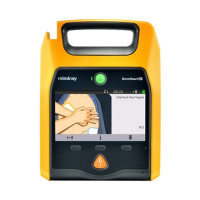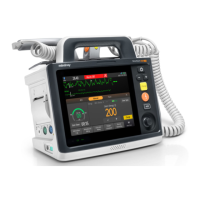Defibrillator/Monitor Operator’s Manual 6 - 1
6 AED
6.1 AED Introduction
This chapter describes how to operate the equipment in the AED Mode. While operating in the AED Mode, the
equipment analyzes the patient’s ECG waveforms and guides you through the defibrillation process.
The equipment starts analyzing the patient’s heart rhythm immediately after entering the AED mode. When a
shockable rhythm is detected, the equipment gives a prompt and automatically starts charging. If a shockable
rhythm is not detected, a “No Shock Advised!” prompt is given. Smart defibrillation analysis goes through
automated external defibrillation until the equipment enters CPR or abnormal electrode pads connection
occurs.
While operating in the AED Mode, ECG signals acquired through electrode pads are displayed. Besides ECG, you
can also select to monitor parameters from SpO
2
, NIBP and CO
2
. Previously set alarms and scheduled
measurements are indefinitely paused and entry of patient information is disabled. Additionally, the Lead Select,
Alarm Pause, NIBP Start/Stop and Main Menu buttons are inactive.
6.2 AED Safety Information
• Defibrillation current can cause operator or bystander severe injury or even death. Never touch the
patient or any metal objects connected to the patient (including the bed or gurney) during
defibrillation.
• Avoid contact between parts of the patient’s body such as exposed skin of head or limbs, conductive
fluids such as gel, blood, or saline, and metal objects such as a bed frame or a stretcher which may
provide unwanted pathways for the defibrillating current.
• Do not allow electrode pads to touch each other or to touch other ECG monitoring electrodes, lead
wires, dressings, etc. Contact with metal objects may cause electrical arcing and patient skin burns
during defibrillation and may divert current away from the heart.
• During defibrillation, air pockets between the skin and electrode pads can cause patient skin burns.
To help prevent air pockets, make sure electrode pads are completely adhered to the skin.
• Do not use dried-out electrode pads.
• Aggressive handling of electrode pads in storage or prior to use can damage the electrode pads.
Discard the electrode pads if they become damaged.
• For patients with implantable pacemaker, the sensitivity and specificity of AED algorithm may be
impaired.
• Successful resuscitation is dependent on many variables specific to the patient’s physiological state
and the circumstances surrounding the patient event. Failure to have a successful patient outcome is
not a reliable indicator of equipment performance. The presence or absence of a muscular response
to the transfer of energy during electrical therapy is not a reliable indicator of energy delivery or
equipment performance.

